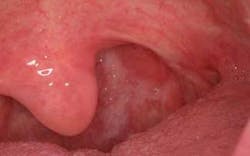The challenges of implementing oral cancer screening technologies
by Kevin D. Huff, DDS, MAGD
For more on this topic, go to www.dentaleconomics.com and search using the following key words: cancer, early diagnosis, adjunctive screening technologies, early detection, Dr. Kevin Huff.
Implementing new oral cancer screening technologies is challenging — not technically, but socially. After several years of experimentation, learning, teaching, and discussion with many trusted colleagues, I have been able to solidify answers to several major questions about early detection technologies. The following are some of the nonclinical calisthenics that we considered in our office prior to implementing them on every patient.
Won't they be offended?
The patient position for dental examination is one of the most vulnerable physical positions to which one may willingly submit, and the prudent clinician is forever cognizant of this. With the now well-known relationships between certain strains of the human papillomavirus and oropharyngeal dysplasia, obtaining a thorough medical history may necessitate frank discussions about sexual history with our patients. Since about 25% of oral dysplasias are discovered in patients with no identifiable common risk factors (smoking and alcohol use, age, race, etc.), the medical history — including a brief social history — is now an even more important component of the oral cancer screening exam than ever before. Furthermore, patients may fail to understand that routine screening of oral cancer is well within the scope of dental practice.
Obviously, patients must grant us permission to obtain necessary information for a thorough examination. Reasonable patient education about the oral cancer exam process and the reasons for possible intrusion into their social privacy are essential, and begun with each patient just after initial seating and prior to the verbal medical history review, before the chair is reclined.
We have found the following carefully phrased script to be effective:
“We believe that all of our patients deserve a very thorough cancer screening examination at each recare visit. With your permission, we'll be using a special light to look around the inside of your mouth and at the back of your throat. But first, may I ask some very personal questions that may help us understand what we're seeing in your mouth?”
What do I charge?
The CDT includes oral cancer screening in all of the examination code descriptions. The code for adjunctive screening technologies (D0431) may be reimbursed by some insurance companies. Aside from insurance coverage, consideration should be given to the importance of early detection in individual practice philosophy, whether technologies require “per patient” costs or are one-time purchases for the practice, in determining fees. In my practice, we opted to make a one-time fee increase of $2.50 for all dental hygiene procedures and exams, and not charge our patients for the adjunctive screening. This was possible because we use the VELscope, which has an initial one-time investment and then “normal” maintenance fees similar to other dental equipment such as operatory lights. We have found that our commitment to thorough cancer screening as an added bonus value to our patients has proven to be an excellent source of referrals and generates a much higher return on investment than ever expected in the form of goodwill and new-patient referrals.
What if I find something?
We often tell our patients, “We're looking for lumps, bumps, or spots that shouldn't be there. If we find anything weird, there's a good chance that we'll be able to take care of it before it's a big problem.” If we find anything obviously visible without adjunctive technologies, we refer the person to a surgeon immediately. With adjunctive tools, however, we're looking for subtle lesions that may become cancer within the next five years. If we find something, we photograph it. If it's still there in 14 days, we perform or refer — depending on our comfort level and patient choice — for a simple surgical biopsy or brush cytology.
As far as oral cancer — or where something is likely to become cancer — goes, my opinion is that we risk a great deal when we make the suggestion to “watch and wait” when we know what we see is unusual, and this may cost the patient his or her life.
Kevin D. Huff, DDS, MAGD, is a practicing general dentist in rural Ohio, a private researcher, author, and dental educator. A clinical instructor at the Case School of Dental Medicine, he lectures nationally about oral cancer screening and biopsy techniques. Contact him at [email protected], or visit www.doctorhuff.net.

